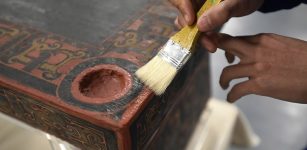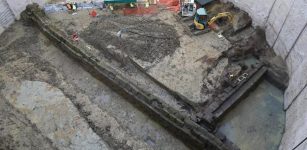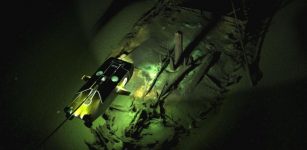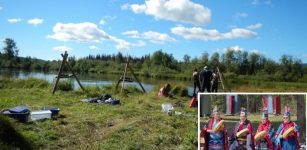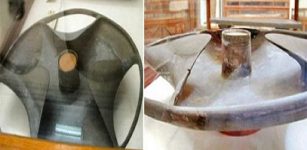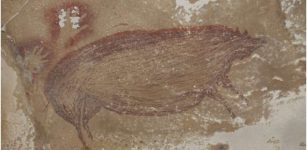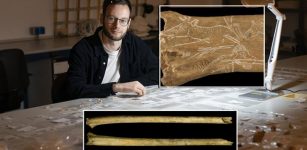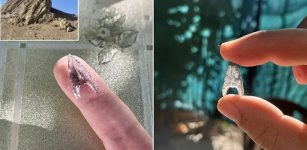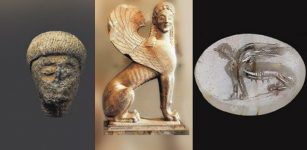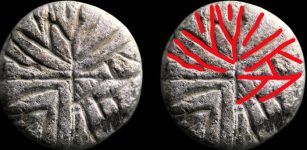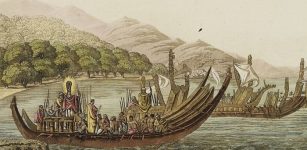Rare Ulfberht Viking Sword Discovered In Suldal, Norway
Jan Bartek - AncientPages.com - A rare Viking sword was found by Øyvind Tveitane Lovra on his family farm in Suldal, Norway.
Scientists say this is probably the first time a sword like this has been found in Rogaland.
"This is very rare. The sword was the greatest status symbol in the Viking Age, and it was a privilege to be allowed to carry a sword. It is not often that we, as archaeologists, get to experience something like this," smiles Lars Søgaard Sørensen in the county council's section for cultural heritage.
It is probably the first time such a sword has been found in Rogaland. With the help of X-ray photography, conservator Hege Hollund has discovered the contours of inscriptions with a cross pattern and perhaps letters on the blade. Credit: Øyvind Nesvåg, Rogaland County Municipality
To the Vikings, a sword was much more than just a weapon. Sword production was complex and labor-intensive, making them scarce and costly. Consequently, they were not widely accessible or prevalent. They were primarily utilized by individuals of high status and rank, such as kings and elite Vikings.
Sørensen, an archaeologist with 25 years of experience, and Kim Thunheim, an archaeologist with 15 years of experience, have never encountered a discovery like this. The two professionals were summoned to the farm Lovra to meet with the individual who found the sword and collect the rare artifact after the finder contacted the county council to register the exceptional find.
Private individuals who find "something old" must contact the county council, which registers finds and forwards them to the Archaeological Museum. This also applies to finds that are no longer completely preserved.
"The farm owner has done everything by the book and should be proud of it. This sword gives us new knowledge about the area", says Thunheim.
Farm owner Øyvind Tveitane Lovra first thought it was scrap iron he found on the field where he was going to sow grass. But when he picked it up, he saw it was a sword. Credit: Rogaland County Municipality.
"I quickly realized that this was not an everyday find. For me, it was a matter of course that I should hand it in. It's about our history, and it's nice to know what has been here in the past. I think there have been many Vikings here in Lovra", says Øyvind Tveitane Lovra, who is a part-time farmer and chief engineer on the ferry MF Hydra that runs between Hjelmeland and Nesvik and a local politician for the Center Party in Suldal municipality.
He compares finding the sword to finding a needle in a haystack.
"We were going to start sowing new grass on a field that had not been plowed for many years. Haakon, my son, and I were plowing the field and picking stones before we took a break when a neighbor visited. Then I caught sight of an iron object that I was about to throw, but just as I was about to toss it, I discovered it was a sword. "Oh, what's happening now?" I thought, says the finder.
The sword is 37 centimeters long, and about half its length is missing. It is still surprisingly well preserved, although Rogaland has worse preservation conditions for swords than, for example, Eastern Norway, Trøndelag, and Northern Norway.
"The fact that the sword has been lying in dense clay means that it is so well preserved," explains Lars Søgaard Sørensen.
An X-ray study of the artifact has provided scientists with valuable information.
X-ray image of the sword found in Suldal. Credit: Archaeological Museum, University of Stavanger
X-ray images show the outlines of inscriptions with a cross pattern and perhaps letters on the blade, or sword blade as it is also called.
This recent discovery could be a renowned Ulfberht sword from the Viking Age or the early Middle Ages. Sigmund Oehrl, a Professor of archeology at the University of Stavanger, explains that these were high-quality swords produced in the Frankish Empire (now Germany) and were marked with the weapon manufacturer's name.
Oehrl states, "When we first saw the sword, we were delighted because it is not very often that we receive swords from the Viking Age. When we saw the X-ray, we were really excited. That there would be an inscription on the blade, we really did not expect that."
The presence of an inscription on the blade is a significant finding, as it could confirm the sword's authenticity and provenance.
Archaeologist Kim Thunheim in Rogaland county municipality was contacted about the rare sword find. After picking it up in Suldal, she delivered it to the Archaeological Museum, where conservator Hege Hollund started the investigations. Credit: Øyvind Nesvåg, Rogaland County Municipality
The inscriptions the professor refers to indicate that the find is more special than at first glance. As far as we know, three to four thousand swords from the Viking Age have been found in Europe. The number of swords with these inscriptions on them, which were found at Lovra, is only around 170. In Norway, around 45 such swords have been found.
Professor Oehrl points out that the researchers are at the beginning of the investigations. The sword has some rust and must be conserved and examined further before they can date the sword more closely and better explain what the inscriptions mean. The sword was probably produced between 900 and 1050.
See also: More Archaeology News
"What are the odds of finding such an intact sword after so many years, when people have gone here and dug in the field for many years?" says finder Øyvind Tveitane Lovra. He believes that the sword has come to the family farm with the Vikings who sailed into the Lovrafjord in their time.
"I know the Vikings sailed into the fjord here and decorated the housewife at Lovra with fine things, including from Ireland. I don't ignore that the chief who owned this sword could be related to me," says Øyvind Tveitane Lovra, smiling.
Written by Jan Bartek - AncientPages.com Staff Writer





